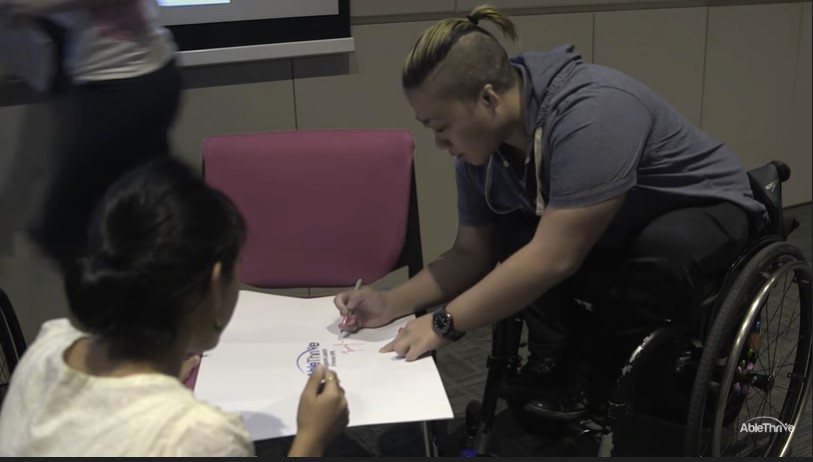When the passion for fashion originates from a heart full of compassion, what comes out are clothes of unparalleled distinction.
Clothing that any person with a disability can be proud of is what fashion design student Elisa Lim created after she capped off her final-year project for LaSalle College of the Arts through an unconventional runway show.
Unconventionally fashionable
In Ms Lim’s very first fashion show, one of her models drove down the runway in a wheelchair, blowing away onlookers with clothes specifically designed for comfort and accessibility especially for those who sit for extended periods of time.
Ms Lim shared a conversation she had with one of the models to a CNA reporter.
The wheelchair-bound model approached Ms Lim, tears welling up in her eyes and saying, “I got worried and asked what happened there….. I’m just really touched that you’re doing something not based on us being just a subject.
“But these apparels do bring a difference in the way we dress up, the way we feel about ourselves.”
That stamp of approval was more or less the start of the journey for Will and Well, the fashion label Ms Lim founded to make inclusive yet attractive apparel for those with disabilities or special needs.
First meltdown
As Ms Lim approached design industry players to seek grants and support in the early months of her business, one particular conversation brought her crashing down to earth.
“The first thing I was asked was: ‘Do you plan to continue doing this?’” Ms Lim recalled. “I was like: ‘What? You don’t even care about the business. What you ask is based on your assumptions that this wouldn’t last long. Where is that coming from?’
“And so that caught me off guard. That was when I realised that we have not been acknowledged by them.”
“Financially cleaned-out”
Lack of recognition was not the first issue that Ms Lim has to struggle with and try to overcome. About six months after launching Will and Well, recurring costs like studio rentals and web hosting fees meant that the S$10,000 she had allocated for the business started running dry and was eventually exhausted.
“I felt like I was missing out a lot of opportunities such as a stable income, the comfort of just working five days a week, from a certain time to a certain time,” she said.
“And I feel like after you graduate, you should hold up some responsibilities as a daughter, and give back in that sense. But when you’re starting out, you’re using all your savings; you barely have anything else to contribute.”
But her compassion and raging entrepreneurial spirit kept her on.
Birth of “fashion icon”
Ms Lim did some serious research. She studied examples in the US and UK and discovered that even with such large markets, clothing brands catering specifically to dementia or wheelchair-bound patients could not survive.
She spoke extensively to patients and caregivers and listened to their clothing problems. The eureka moment came when she asked one beneficiary what she thought was most important when dressing up.
“She said: ‘First it has to look good on me. And then sure, if it makes it easier for me … it will be like a bonus for me.’ That was when my perspective really changed,” she said.
“Everyone wants to look good when it comes to dressing up. It’s important for physical well-being with the function, but you have to acknowledge that fashion has the capacity to give you an identity.”
This fitted nicely with something Ms Lim observed on her commutes on the MRT, specifically at the station lifts: “They designed that for the minority – for persons with disabilities, pregnant women and the elderly. But more often than not, you see the abled people dashing into the lift first.
”I wish people were more considerate, but it means that the design is very successful, so much so that everyone wants a piece of it.”
This would become her design ethos: Creating clothes that were first and foremost attractive, but with inclusive yet subtle features that could benefit everyone.
Will and Well had finally found its space after she asked the questions — “Why does it have to be so exclusive?” she asked. “Why does it have to be only aesthetics-focused?”
Indeed, Ms Lim sees a future where inclusive fashion becomes normal.

